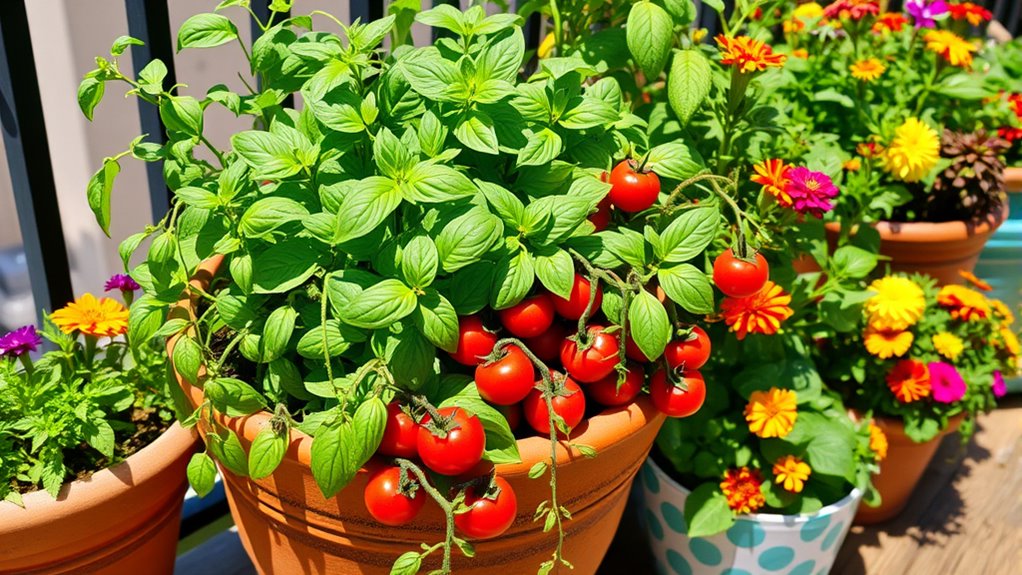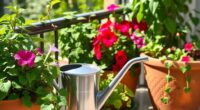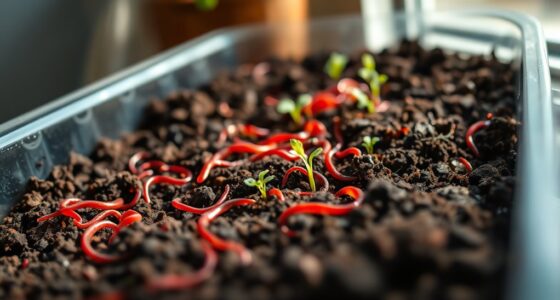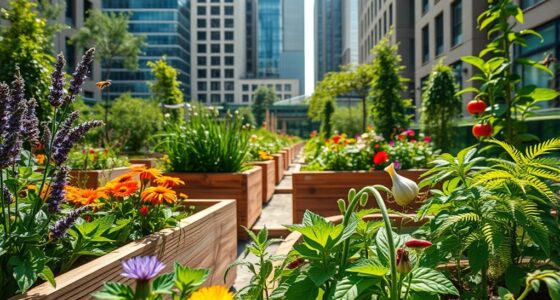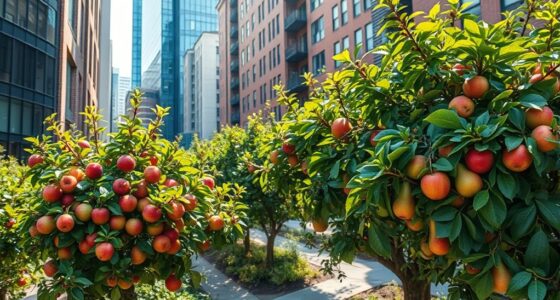Companion planting in container gardens helps boost plant health, keep pests away, and make the most of limited space. You can pair plants like tomatoes with basil or marigolds with cucumbers to naturally fend off pests and enhance flavor. Choosing the right containers, soaking them in well-draining soil, and mixing colorful plants can create a lively, productive garden. To discover more tips on designing and managing your container garden, keep exploring the strategies that can make your space thrive.
Key Takeaways
- Select compatible plant pairs like tomatoes with basil or marigolds with cucumbers to enhance growth and pest resistance.
- Use pest-repelling plants such as cilantro, chives, and dill to naturally deter pests in container gardens.
- Incorporate beneficial insects by planting flowers like calendula and petunias to promote natural pest control.
- Ensure proper container size, drainage, and nutrient-rich soil to support healthy, thriving companion plants.
- Design with varying heights, colors, and bloom times to create a vibrant, productive container garden.
Benefits of Companion Planting in Containers

Companion planting in containers offers numerous benefits that can enhance your gardening experience. By practicing companion planting, you naturally improve plant health through pest deterrence and attracting beneficial insects. These beneficial insects help keep pests at bay, reducing the need for chemical treatments. Using self-watering planter pots can further support healthy growth by maintaining consistent moisture levels for your plants. Plus, pairing compatible plants maximizes space efficiency in your container gardens, allowing you to grow more in less area. Certain combinations, like basil with tomatoes or marigolds with cucumbers, are proven to repel specific pests and improve plant growth. Additionally, companion plants can boost soil fertility and nutrient availability, which supports organic gardening practices. Incorporating companion planting techniques can also foster a more resilient and sustainable garden ecosystem. Overall, strategic plant pairings lead to higher yields, healthier plants, and a more enjoyable gardening process with less maintenance.
Popular Plant Pairings for Container Gardens
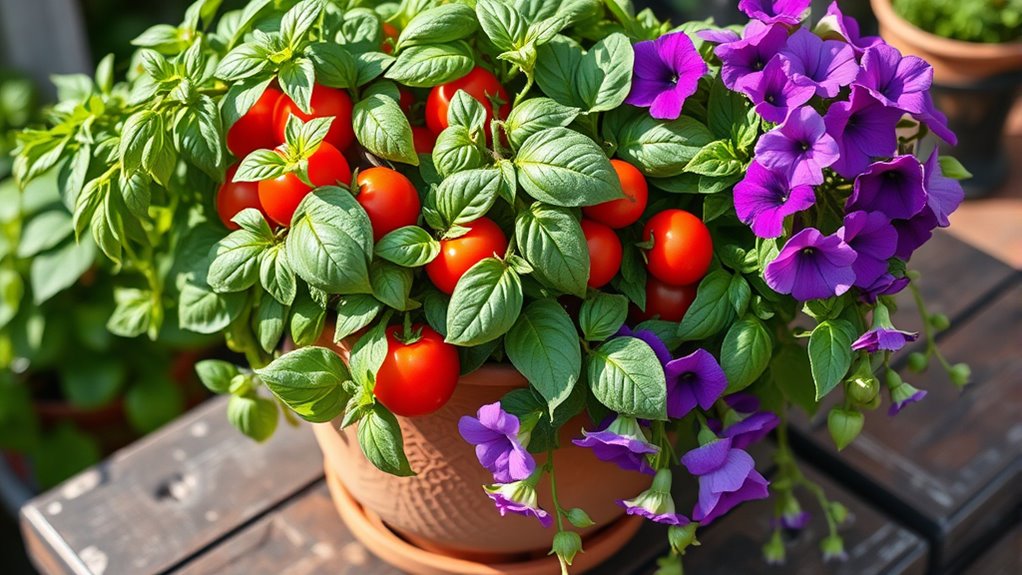
Choosing the right plant pairings can greatly boost the success of your container garden. Effective plant combinations enhance garden design, promote pest control, and attract beneficial insects. Popular plant pairings include tomatoes with basil, which repels pests and improves flavor, and marigolds with cucumbers to deter aphids and beetles. Lettuce benefits from chives, as their scent attracts beneficial insects, while radishes provide shade for nasturtiums, which keep pests away. Leeks and carrots are also compatible; carrots shade leeks, and hoverflies attracted by leeks help control pests on carrots. These vegetable companions and herb garden ideas create a thriving, pest-resistant environment. Using companion planting principles, you can develop creative planting ideas and maximize your container gardening success. Incorporating plant compatibility strategies can further improve your garden’s overall health and productivity. Additionally, understanding plant interactions can help you select combinations that support each other’s growth and resilience. Moreover, selecting plants based on their growth habits can optimize space and resource use in your container garden.
Selecting the Right Container and Soil for Your Plants
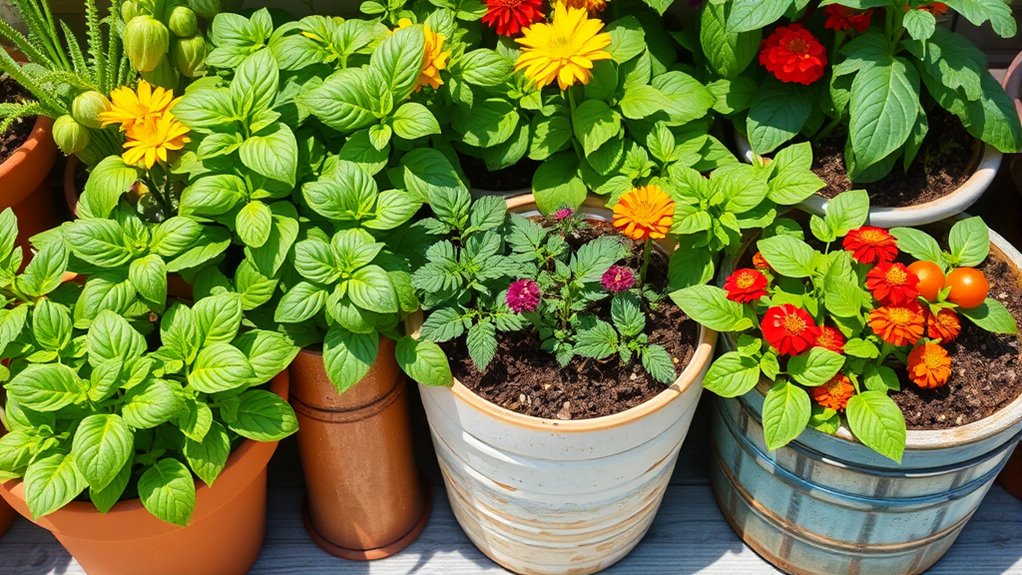
Selecting the right container and soil is essential for healthy plant growth in your container garden. Choose containers with proper drainage holes to prevent waterlogging and root rot. Picking a size that supports your plant’s mature root system is also important. Adequate drainage and size help prevent issues like waterlogging, promoting healthier roots and overall plant vitality. Additionally, selecting containers made from durable materials that can withstand outdoor conditions ensures longevity and safety for your plants. Use a high-quality potting mix, like Miracle-Gro® Moisture Control® or Organic™ Outdoor Potting Mix, that offers nutrient-rich, moisture-retentive properties. Incorporating artistic elements into your container design can also enhance your home decor while providing a healthy environment for your plants. The container material—such as terracotta, ceramic, or plastic—should withstand weather and avoid leaching harmful substances. Fill your container with a well-draining, nutrient-rich soil blend to promote healthy root development. Ensuring your plants get the soil nutrients they need is crucial. Proper container size and soil blend support ideal growth, airflow, and moisture retention, setting the foundation for a thriving container garden.
Managing Pests and Promoting Healthy Growth
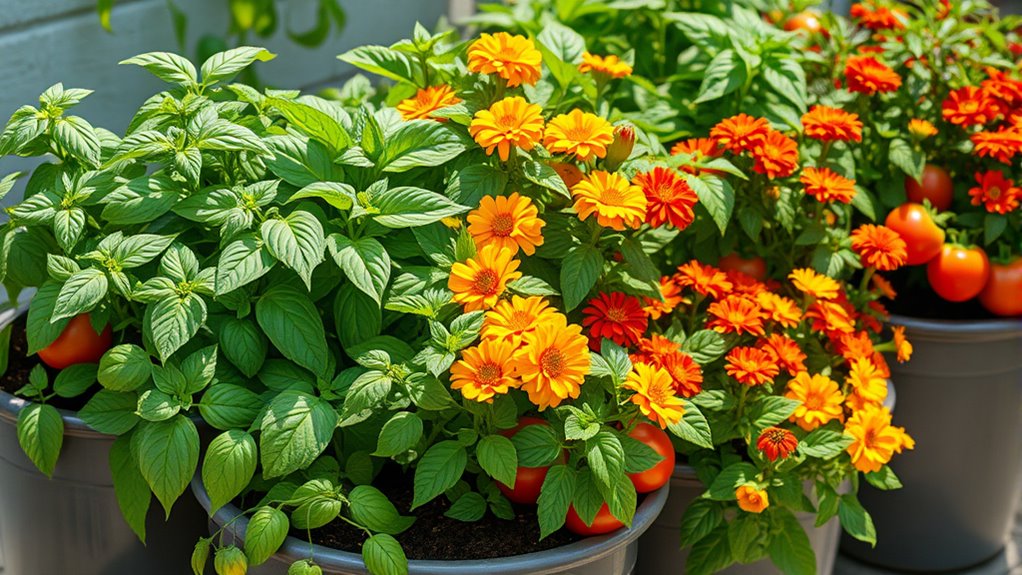
To effectively manage pests and promote healthy growth in your container garden, incorporating pest-repelling plants is a smart strategy. Companion planting with herbs like basil, cilantro, chives, and dill helps deter pests naturally and attracts beneficial insects like hoverflies and predatory wasps, aiding pest control organically. A natural pest control method enhances the sustainability of your garden by reducing reliance on chemical pesticides. Proper plant pairing and spacing improve airflow and reduce excess moisture, minimizing conditions for pests and diseases. Avoid planting crops that share pests or diseases, such as onions near carrots, to prevent pest spread. Additionally, understanding how headphone jacks can be used to connect various audio devices can help gardeners listen to instructional videos or music while working outdoors, making gardening more enjoyable. Incorporating pest-repelling plants near vulnerable vegetables encourages a balanced ecosystem, reducing the need for chemical pesticides. For organic gardeners, this approach can also support plant health by naturally deterring harmful insects and promoting growth.
Tips for Designing a Colorful and Productive Container Garden

Designing a vibrant and productive container garden starts with thoughtful plant placement and color coordination. To achieve a colorful and lively display, choose contrasting flowering plants like marigolds or nasturtiums paired with leafy greens and herbs. Incorporating plant combinations that attract beneficial pollinators, such as calendula or petunias, to boost bloom diversity and support pollination. Use variations in plant height and foliage texture—tall basil or trailing thyme—to add depth and visual interest. Select plants with overlapping bloom times to ensure a continuous bloom and sustained color throughout the season. Combining edible flowers with herbs and vegetables not only enhances visual appeal but also maximizes productivity, making your container garden both beautiful and functional. Additionally, understanding AI data analysis can help you select plants based on seasonal trends and consumer preferences, optimizing your garden’s success. Proper soil health practices can further improve plant growth and resilience in container environments. Maintaining drainage systems in your containers is also essential to prevent overwatering and promote healthy root development, especially when considering watering techniques for different plant types.
Frequently Asked Questions
What Plants Grow Well Together in Containers?
You can grow a variety of plants together in containers for better growth and pest control. For example, plant tomatoes with basil to repel pests, and lettuce with chives to attract beneficial insects.
Radishes thrive alongside nasturtiums, while leeks and carrots share similar roots and attract helpful insects.
Marigolds with cucumbers help deter pests and attract pollinators, creating a healthy, productive container garden.
What Is the Best Mix for Container Gardening?
You might think any soil will do, but the best mix for container gardening actually needs specific ingredients. Use a high-quality, well-draining potting soil like Miracle-Gro Moisture Control® that retains moisture and improves aeration.
Mix in organic matter like compost, and add perlite or vermiculite for drainage. This combination creates a balanced, pH-friendly environment, ensuring healthy roots and vibrant plants—perfect for thriving container gardens.
What Vegetables Go Together in a Planter Box?
In your planter box, you should mix vegetables that naturally support each other. For example, plant tomatoes with basil to repel pests and improve flavor.
Carrots grow well with leeks and chives, which help keep pests away.
Radishes can be paired with cucumbers and lettuce for quick harvests.
Green beans thrive with corn and marigolds, and peppers do well alongside herbs like basil and onions.
Avoid planting incompatible pairs to guarantee healthy growth.
What Is the Rule of Thumb for Container Gardening?
Think of container gardening as a symphony—you need harmony for everything to thrive. Your rule of thumb is to pick plants with similar light, water, and soil needs to create this harmony.
Use appropriately sized containers, arrange taller plants so they don’t overshadow shorter ones, and guarantee good airflow.
Regularly monitor watering, fertilizing, and spacing, like a conductor tuning each instrument for perfect growth.
Conclusion
By mastering companion planting in your containers, you’ll turn a simple garden into a lush, unstoppable paradise bursting with color, flavor, and energy. Your plants will become superhero teams, fighting pests and boosting growth like an unstoppable force of nature. Get ready to impress everyone with a garden so vibrant and bountiful, it’ll make the neighborhood green with envy. Immerse yourself and watch your container garden transform into a living, breathing masterpiece!
